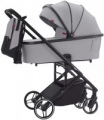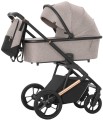Foldable carrycot
Pushchairs in which the carrycot has a foldable design. This feature simplifies the storage and transportation of the stroller, when folded, the
foldable carrycot takes up much less space.
Carrycot carry handle
The carrycot carry handle for carrying is mounted on the carrycot and makes it easy to carry it from place to place — for example, if you need to remove the carrycot for cleaning and then put it back. The handle can have a different shape — in the form of an arc attached to the sides of the carrycot, in the form of a hood cutout, etc.
Frame material
The main material from which the frame of the pushchair is made.
— Aluminium. The material used in the vast majority of modern pushchairs of all price categories. This is due to a number of advantages: aluminium is light and at the same time durable, it does not rust and is not afraid of moisture, it lasts a long time, it looks nice, but it is relatively inexpensive — somewhat more expensive than steel, but noticeably cheaper than more advanced materials like carbon.
— Steel. Steel frames are as strong as aluminium frames, and they are much cheaper. On the other hand, they are quite heavy, so steel is used less often in pushchairs.
— Magnesium alloy. Premium Material: Stronger and more durable than aluminium, just as lightweight, but at a significantly higher cost. It is extremely rare, in single models of expensive pushchairs.
— Carbon. Another high-end material: carbon fiber filled with plastic. This combination gives excellent strength - comparable to steel — at a very low weight. However, carbon is very expensive, and these advantages are rarely decisive for pushchairs — in most cases simpler materials are enough. That is why carbon frames have not become widespread.
— Plastic. Plastic itself is easy to manufacture and relatively cheap; it is also not as cold to the hands in cool weather as aluminium or steel. However, modern pushchairs very rarely have frames made of this material. The fact is that low-cost vari...eties of plastic are not strong enough for this; and high-quality varieties cost accordingly - their price is close to aluminium, or even higher.
— Fibreglass. In this context, "fibreglass" typically refers to glass fibers mixed with plastic filler. Unlike conventional window glass, glass fibers are flexible and strong. The plastic filler enhances durability by offering scratch and tear resistance. The result is a material that is lightweight and very strong. However, fibreglass is prone to brittleness, especially with point impacts, and is susceptible to abrasion. As a result, it isn't widely used in pushchairs.
Front wheels diameter
The diameter of the front wheels installed in the stroller.
At the same time, the front wheels are not as important for mobility as the rear wheels: for example, to overcome obstacles, the stroller is often lifted "on its toes" by tilting it towards itself, with only the rear wheels working. Therefore, the diameter of the front wheels may be noticeably smaller than the rear wheels. It should be noted here that the small size also has its advantages — the wheels are lighter.
Speaking of specific numbers, diameter
up to 15 cm is considered very modest,
16 — 20 cm — small,
21 — 25 cm — medium,
26 — 30 cm is larger than average and
more than 30 cm is large.
Rear wheels diameter
The diameter of the rear wheels installed in the stroller.
The larger the wheel — the better it overcomes obstacles and bumps, the more convenient it is to drive the stroller over mud, snow and other difficult surfaces. For the rear wheels these moments are most relevant: for example, when driving the stroller over obstacles, it is usually tilted towards itself, so that the front wheels are in the air, and the rear wheels have to overcome the obstacle. On the other hand, small wheels weigh less and are easier to move, they are better suited for flat surfaces. So choose a stroller on this indicator should take into account the roads on which it has to be driven. If you plan to move on flat floors, good asphalt and stroller ramps — it is worth choosing small wheels, up to 20 cm. For difficult terrain, driving on mud and snow, regular overcoming steps and curbs it makes sense to pay attention to wheels in 30 cm and larger. And the diameter of 20 — 30 cm is an average option — it is suitable if you have to ride mainly on flat surfaces, but occasionally there is a need to overcome obstacles.
Chassis width
The distance between the side wheels of the pushchair; this generally corresponds to the overall width of the pushchair. If the front and rear widths are different, the greatest distance is indicated, usually on the rear wheels; the same wheels are used to measure the width of three-wheeled models.
In general, the wider the chassis, the more stable the pushchair is and the more difficult it is to tip it over. On the other hand, greater width can cause problems in tight spaces such as narrow hallways and doorways, elevators, etc. The narrowest modern pushchairs have a width
of up to 45 cm, the widest —
more than 70 cm (these are mainly models for twins or triplets , where two seats are side-by-side). Models
46 – 50 cm are also considered quite narrow, a width of
51 – 55 cm can be called small,
56 – 60 cm — medium,
61 – 65 cm — more than average,
65 – 70 cm — large.
Carrycot dimensions (LxW)
Dimensions of the carrycot provided in the kit.
Partly the rule "the bigger the better" works here: a large carrycot gives a good reserve for the period of growth of the baby, in winter you can put the baby dressed in warm clothes in it, and in summer the extra space in the carrycot provides good ventilation. On the other hand, large carrycots are more bulky, weigh more and cost more.
Seat width
The width of the seat installed in the stroller.
When selecting a seat, focus on the seat width, considering the child's build and allowing space for future growth, rather than the overall dimensions.
Weight (complete)
The total weight of the assembled pushchair. For universal models (see "Design"), this paragraph usually indicates the weight with the seat unit installed: such an accessory is used for a longer time than the carrycot, therefore its characteristics are considered the most important. In addition, the difference in weight between cradles and walking blocks usually does not exceed 700 – 800 g (there are exceptions, but quite rarely).
Comparing similar models, a lighter pushchair may offer more convenience, but it often comes at the expense of reliability or a higher price compared to a relatively heavier counterpart. It's important to note that weight varies based on the pushchair type (refer to "Design"). Heavier pushchairs provide stability, reducing the risk of tipping over. The lightest models, weighing
less than 5 kg, refer to pushchairs and single-seat ones. Models in the
6 – 10 kg are also mostly pushchairs, including variations for twins. The
11 – 15 kg range is standard for universal pushchairs and transformers. Models weighing
16 – 20 kg are notably heavy, while those
exceeding 20 kg are rare and found among high-end double-seat pushchairs.

